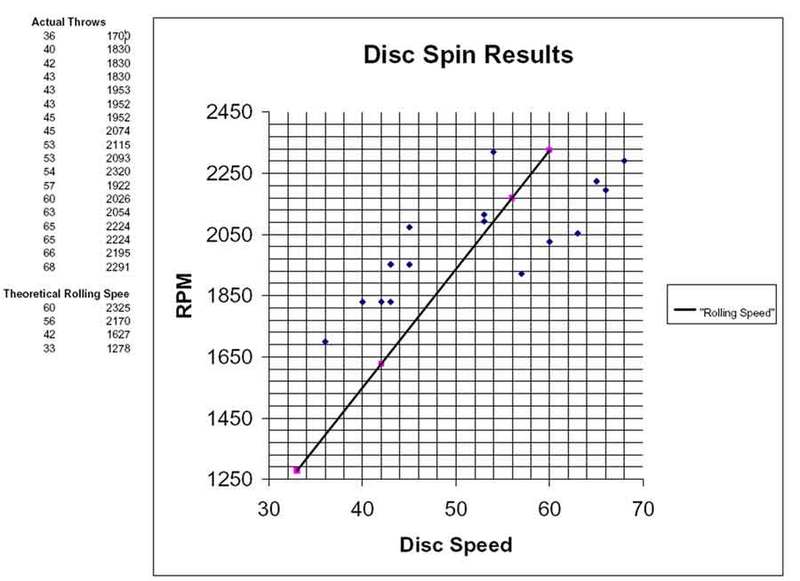Disc Spin Test Results
I have designed and tested a method for measuring the RPM's of a thrown disc. This design utilizes an on board LCD readout taken from a Powerball Gyroscope. This small computer counts the revolutions of a revolving magnet. It can keep track of total RPM's, as well as a maximum RPM which is conveniently held in memory until either exceeded or manually reset. I then constructed a lightweight vertical tail/boom and fastened it to a pin in the discs center. I then attached a doughnut shaped magnet to the boom. This magnet is set to pass directly over the computer sensor. When the disc is the thrown the tail tracks in a straight back position, while the sensor and disc spin.
My initial prediction was that when thrown, a disc would essentially be rolling out of your hand. For an example a golf disc rolling along the ground at 60 mph would be spinning at 2325 RPM, and I thought the same RPM would happen with a disc is thrown through the air at 60 mph.
My test plan was to use my radar gun in conjunction with the RPM disc to get an accurate range of data.The results can be seen in the graph below. I was definitely surprised by the variance in spin. I made an effort to throw each test shot with the same form and technique. As a disc is thrown harder, say over 70 mph the spin of the disc can actually drop below what it was at 50 mph. I can throw 80 mph at my max and the spin at this speed is right around 2000 rpm. A theory is that the wrist can't keep up with really fast arm speeds, and can't supply an ever increasing amount of spin. As an example I never broke 2330 RPM during my tests, and that spin was with a 54 mph throw!
I also tested half a dozen sidearm throws. I have a "no wobble" side arm that uses allot of wrist snap. The results were conclusive that sidearm has 25% less inherent spin than a backhand throw. I assume that is why so many peoples sidearm throws wobble. It is also possible to increase or decrease spin purposefully, although I found this to be impractical and awkward. A disc with extra spin does seem to resist low speed fade better than a disc with less spin. Strangely, when I tried to spin the hell out of a disc it would sometimes show less rpm's than a normal throw?!
I realize that individual form and technique might show very different results. My friend Jim tried the RPM disc and seemed to have a noticeably higher spin-to-speed ratio than me. He really cocks his wrist, while I keep mine tight like a spring. I hope you guys find these results interesting!
note: Erin is currently building a disc launching machine, which spins the disc up at a chosen rpm and then launches it. This device has adjustable hyzer angle, and adjustable vertical angle of release. It has been tested ejecting a disc @109 mph into a radar gun, then net. (historically, the fastest recorded disc throw was 85 mph). This device will then make it possible to find the correlation between spin and distance. It will also allow any disc to be measured for distance and any desired flight characteristics during calm conditions and in a precise and repeatable way. It's cool. Will post pics and results in the near future.

